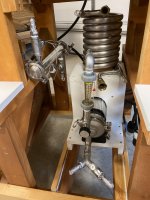I use a HERMS. My grain bed compacts enough that the flow cannot keep up with my pump - cavitation. So I stirred the mash, which solved the problem. For about 5 minutes. When I throttle back the flow, so as to minimize pulling the bed down and compacting it, the temp doesn't rise, so I need to keep the liquid flow up there.
Rather than babysitting the mash for an hour and stirring every five minutes, does anyone have any suggestions? I was looking for something I could clip to the side of my SS Brewtech mash tun for auto stirring. I'd have to leave the cover off, which I guess may not be a problem as the HERMS is pretty good at maintaining temp.
Thanks for your help.
Rather than babysitting the mash for an hour and stirring every five minutes, does anyone have any suggestions? I was looking for something I could clip to the side of my SS Brewtech mash tun for auto stirring. I'd have to leave the cover off, which I guess may not be a problem as the HERMS is pretty good at maintaining temp.
Thanks for your help.



